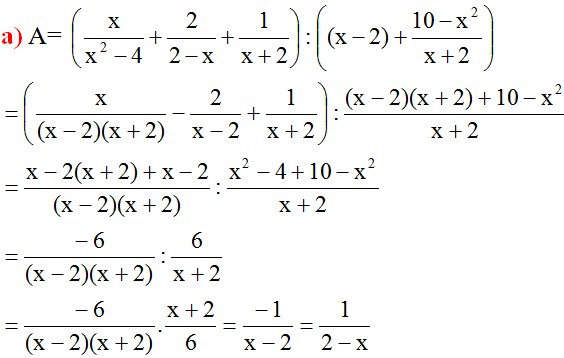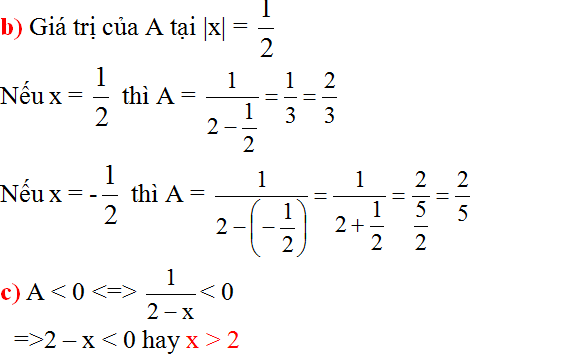Hãy nhập câu hỏi của bạn vào đây, nếu là tài khoản VIP, bạn sẽ được ưu tiên trả lời.

Lời giải của bạn Nhật Linh đúng rồi, tuy nhiên cần thêm điều kiện để A có nghĩa: \(x\ne\pm2\)

a) P xác định \(\Leftrightarrow\hept{\begin{cases}2x+10\ne0\\x\ne0\\2x\left(x+5\right)\ne0\end{cases}\Leftrightarrow x\ne\left\{-5;0\right\}}\)
b) \(P=\frac{x^2+2x}{2x+10}+\frac{x-5}{x}+\frac{50-5x}{2x\left(x+5\right)}\)
\(P=\frac{x^2\left(x+2\right)}{2x\left(x+5\right)}+\frac{2\left(x-5\right)\left(x+5\right)}{2x\left(x+5\right)}+\frac{5\left(10-x\right)}{2x\left(x+5\right)}\)
\(P=\frac{x^3+2x^2+2x^2-50+50-5x}{2x\left(x+5\right)}\)
\(P=\frac{x^3+4x^2-5x}{2x\left(x+5\right)}\)
\(P=\frac{x^3+5x^2-x^2-5x}{2x\left(x+5\right)}\)
\(P=\frac{x^2\left(x+5\right)-x\left(x+5\right)}{2x\left(x+5\right)}\)
\(P=\frac{\left(x+5\right)\left(x^2-x\right)}{2x\left(x+5\right)}\)
\(P=\frac{x\left(x-1\right)}{2x}\)
\(P=\frac{x-1}{2}\)
c) Để P = 0 thì \(x-1=0\Leftrightarrow x=1\)( thỏa mãn ĐKXĐ )
Để P = 1/4 thì \(\frac{x-1}{2}=\frac{1}{4}\)
\(\Leftrightarrow4\left(x-1\right)=2\)
\(\Leftrightarrow4x-4=2\)
\(\Leftrightarrow4x=6\)
\(\Leftrightarrow x=\frac{3}{2}\)( thỏa mãn ĐKXĐ )
d) Để P > 0 thì \(\frac{x-1}{2}>0\)
Mà 2 > 0, do đó để P > 0 thì \(x-1>0\Leftrightarrow x>1\)
Để P < 0 thì \(\frac{x-1}{2}< 0\)
Mà 2 > 0, do đó để P < 0 thì \(x-1< 0\Leftrightarrow x< 1\)

d, A nguyên dương <=> \(\frac{-4}{2+x}\) nguyên dương
<=> \(\begin{cases}2+x< 0\\2+x\inƯ4\end{cases}\)
<=> 2 + x \(\in\) {-1; -2; -4}
Thay 2 + x = -1 => x = -3
2 + x = -2 => x = -4
2 + x = -4 => x = -6
Vây x \(\in\left\{-3;-4;-6\right\}\)
a) x khác 0 ; 2 ;-2
\(A=\left(\frac{1}{x-2}-\frac{2x}{4-x^2}+\frac{1}{2+x}\right).\left(\frac{2}{x}-1\right)\)
\(=\left(\frac{x+2}{\left(x-2\right)\left(x+2\right)}+\frac{2x}{\left(x-2\right)\left(x+2\right)}+\frac{x-2}{\left(x-2\right)\left(x+2\right)}\right).\frac{2-x}{x}\)
\(=\frac{4x}{\left(x-2\right)\left(x+2\right)}.\frac{2-x}{x}=-\frac{4}{x+2}\)
b) Ta có: 2x2+x=0
<=>x.(2x+1)=0
<=>x=0 (loại) hoặc x=-1/2
Khi x=-1/2 => A=\(-\frac{4}{-\frac{1}{2}+2}=-\frac{8}{3}\)
c)Để A=1/4
Thì: \(-\frac{4}{x+2}=\frac{1}{4}\Rightarrow x+2=-16\Leftrightarrow x=-18\)(nhận)
Vậy x=-18 thì A=1/4
d)Để A nguyên dương thì x+2 thuộc ước âm của 4
=>x+2=-1 hoặc x+2=-2 ; hoặc x+2=-4
=>x=-3 hoặc x=-4 hoặc x=-6
Vậy x=-3 hoặc x=-4 hoặc x=-6 thì A nguyên dương

a) \(\left(\dfrac{x}{x^2-4}+\dfrac{2}{2-x}+\dfrac{1}{x+2}\right):\left(x-2+\dfrac{10-x^2}{x+2}\right)\)
\(\Leftrightarrow\left(\dfrac{x-2x-4+x-2}{x^2-4}\right):\left(\dfrac{x^2-4+10-x^2}{x+2}\right)\)
\(\Leftrightarrow\left(\dfrac{-6}{x^2-4}\right).\left(\dfrac{x+2}{6}\right)\Leftrightarrow\dfrac{1}{2-x}\)
b) với \(x^2=2x\Leftrightarrow x^2-2x+1-1=0\)
\(\Leftrightarrow\left(x-1\right)^2=1\Leftrightarrow\left[{}\begin{matrix}x-1=1\\x-1=-1\end{matrix}\right.\Leftrightarrow\left[{}\begin{matrix}x=2\left(KTM\right)\\x=0\left(TM\right)\end{matrix}\right.\)
Vậy với x=0 thì A = \(\dfrac{1}{2}\)
c) A nhận giá trị nguyên dương tức \(\dfrac{1}{2-x}\) nhận giá trị dương
Để A nhận giá trị dương thì
\(2-x\inƯ_{\left(1\right)}\)\(\Leftrightarrow2-x\in\left\{-1;1\right\}\)
| \(2-x\) | -1(loại) | 1 |
| \(x\) | 3(loại) | 1 |
Vậy x=1 thì A nhận giá trị dương

a,ĐK: \(\hept{\begin{cases}x\ne0\\x\ne\pm3\end{cases}}\)
b, \(A=\left(\frac{9}{x\left(x-3\right)\left(x+3\right)}+\frac{1}{x+3}\right):\left(\frac{x-3}{x\left(x+3\right)}-\frac{x}{3\left(x+3\right)}\right)\)
\(=\frac{9+x\left(x-3\right)}{x\left(x-3\right)\left(x+3\right)}:\frac{3\left(x-3\right)-x^2}{3x\left(x+3\right)}\)
\(=\frac{x^2-3x+9}{x\left(x-3\right)\left(x+3\right)}.\frac{3x\left(x+3\right)}{-x^2+3x-9}=\frac{-3}{x-3}\)
c, Với x = 4 thỏa mãn ĐKXĐ thì
\(A=\frac{-3}{4-3}=-3\)
d, \(A\in Z\Rightarrow-3⋮\left(x-3\right)\)
\(\Rightarrow x-3\inƯ\left(-3\right)=\left\{-3;-1;1;3\right\}\Rightarrow x\in\left\{0;2;4;6\right\}\)
Mà \(x\ne0\Rightarrow x\in\left\{2;4;6\right\}\)

Câu 1 :
a) Rút gọn P :
\(P=\dfrac{x+1}{3x-x^2}:\left(\dfrac{3+x}{3-x}-\dfrac{3-x}{3+x}-\dfrac{12x^2}{x^2-9}\right)\)
\(P=\dfrac{x+1}{x\left(3-x\right)}:\left[\dfrac{\left(3+x\right)^2}{\left(3-x\right)\left(3+x\right)}-\dfrac{\left(3-x\right)^2}{\left(3-x\right)\left(3+x\right)}-\dfrac{12x^2}{\left(3-x\right)\left(3+x\right)}\right]\)
\(P=\dfrac{x+1}{x\left(3-x\right)}:\left(\dfrac{9+6x+x^2-9+6x-x^2-12x^2}{\left(3-x\right)\left(3+x\right)}\right)\)
\(P=\dfrac{x+1}{x\left(3-x\right)}:\dfrac{12x-12x^2}{\left(3-x\right)\left(x+3\right)}\)
\(P=\dfrac{x+1}{x\left(3-x\right)}.\dfrac{\left(3-x\right)\left(x+3\right)}{12x\left(1-x\right)}\)
\(P=\dfrac{\left(x+1\right)\left(x+3\right)}{12x^2\left(1-x\right)}\)


ĐKXĐ : \(x\ne0,x\ne\pm2\)
Câu a :
\(A=\left(\dfrac{1}{x-2}-\dfrac{2x}{4-x^2}+\dfrac{1}{x+2}\right).\left(\dfrac{2}{x}-1\right)\)
\(=\dfrac{x+2+2x+x-2}{\left(x-2\right)\left(x+2\right)}.\left(\dfrac{2}{x}-1\right)\)
\(=\dfrac{4x}{\left(x-2\right)\left(x+2\right)}\times\dfrac{2-x}{x}\)
\(=-\dfrac{4}{x+2}\)
Câu b :
Ta có : \(2x^2+x=0\Leftrightarrow x\left(2x+1\right)=0\Leftrightarrow\left[{}\begin{matrix}x=0\\x=-\dfrac{1}{2}\end{matrix}\right.\)
Thay \(x=0\) vào A ta được \(-\dfrac{4}{0+2}=-2\)
Thay \(x=-\dfrac{1}{2}\) vào A ta được \(-\dfrac{4}{-\dfrac{1}{2}+2}=-\dfrac{8}{3}\)
Câu c :
Để \(A=\dfrac{1}{2}\) thì \(-\dfrac{4}{x+2}=\dfrac{1}{2}\)
\(\Leftrightarrow x+2=-8\Leftrightarrow x=-10\)
Câu d :
Để A nguyên dương thì \(-4⋮x+2\)
Xét :
\(Ư\left(-4\right)=-4;-2;-1;1;2;4\)
\(\left\{{}\begin{matrix}x+2=-4\\x+2=-2\\x+2=-1\end{matrix}\right.\Rightarrow\left\{{}\begin{matrix}x=-6\left(N\right)\\x=-4\left(N\right)\\x=-3\left(N\right)\end{matrix}\right.\)
\(\left\{{}\begin{matrix}x+2=1\\x+2=2\\x+2=4\end{matrix}\right.\Rightarrow\left\{{}\begin{matrix}x=-1\left(N\right)\\x=0\left(L\right)\\x=2\left(L\right)\end{matrix}\right.\)
Vậy có 4 giá trị của x thì A nguyên : \(\left\{{}\begin{matrix}x=-6\\x=-4\\x=-3\\x=-1\end{matrix}\right.\)
bạn ơi cảm ơn bạn nhiều